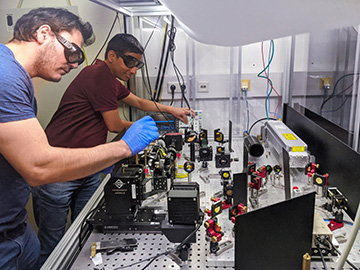![]()
The miniaturized optical resonator is located in the central slot of the sleeve mount. [Image: © Uni Bonn]
Miniaturized optical resonators are powerful tools for enhancing the interaction between light and matter. For practical applications, these optical building blocks—which, in their simplest form, consist of two parallel mirrors reflecting light back and forth—must be compact and highly stable, with a large free-spectral range.
Now, researchers in Germany and Mexico believe they’ve found a simple, robust and versatile approach to constructing fiber Fabry-Pérot cavities (FFPCs) that combine all of the above qualities, and could be readily implemented in quantum and spectroscopic applications, among others (Opt. Express, doi: 10.1364/OE.412273).
Small footprint, big challenges
Miniaturized optical resonators employ a compact mirror arrangement to spatially concentrate light in a small volume, store light for some period and spectrally filter around an adjustable wavelength. As such, these optical microfilters have found broad utility in applications ranging from spectroscopy and communications to quantum technology. Miniaturized FFPCs—which feature mirrors directly fabricated onto the ends of optical fibers—have emerged as a promising optical resonator platform in the past decade. But it’s been difficult to provide a small footprint, high stability and spectral tunability simultaneously in the inherently fiber-coupled device.
The researchers behind the new work realized that building FFPCs inside of slotted glass ferrules could potentially solve some of these problems and pave the way for a more versatile miniaturized component. This arrangement, the Universität Bonn, Germany, and Universidad de Guanajuato, Mexico, researchers explain, would reduce the complexity of the assembly process, increase passive stability and guarantee an inherent alignment of the resonators.
Threading fiber through glass

Carlos Saavedra (left) and Deepak Pandey (right) prepare the fiber Fabry-Pérot cavity for test measurements. [Image: © Uni Bonn]
To construct the stable, tunable FFPC, the team fabricates reasonably precise mirrors at the ends of the hair-thin optical fiber using CO2-laser ablation. Then, say the researchers, “all we have to do is to insert the fibers into the ferrule guides, which provide easy alignment at the sub-micrometer scale.” The final step is to glue the arrangement on top of a piezo-actuator, which allows for fast scanning over the free-spectral range of the resonator.
The team constructed three monolithic FFPCs following this proposed design—half-slot, full-slot and triple-slot geometries. To characterize their components, the researchers directed 780-nm-wavelength light through an electro-optic modulator and non-polarizing beam splitter; the light is then coupled into the fiber that leads to the FFPC. The reflected and transmitted laser light from the FFPC was monitored by two photodiodes, and the cavity length and linewidth were scanned and measured.
Based on their experiments, the researchers say, two of the three FFPCs “allow full tunability (defined by tuning across an entire so-called free spectral range) but still maintain all other features,” including high temporal stability, high spectral resolution, energy concentration and direct integration with fiber optics.
A versatile solution
This versatility, they say, means that potential applications are multifold. For example, in quantum technology, which calls for a high concentration of light energy to achieve strong light–matter coupling, the FFPC could provide precisely that while also offering tunability to the relevant coupling resonance. The team also points out that FFPCs are “spectroscopic devices by nature,” and the small footprint of the component could open up new spectroscopy applications under adverse conditions, such as in airborne or space missions.
In the short term, the researchers plan to demonstrate the feasibility and sensitivity of the devices for spectroscopic applications. As for technical improvements to the resonator design, they want to improve the coupling of the integrated fibers through better mode matching.
